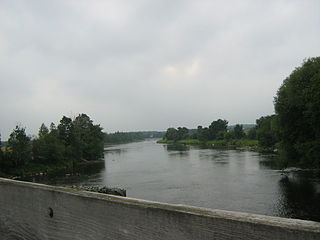Bécancour River
| Bécancour River | |
|---|---|
 | |
 | |
| Native name | Rivière Bécancour (French) |
| Location | |
| Country | Canada |
| Province | Quebec |
| Region | Chaudière-Appalaches, Centre-du-Québec |
| Physical characteristics | |
| Source | Bécancour Lake |
| • location | Thetford Mines, Chaudière-Appalaches, Quebec, Canada |
| • coordinates | 46°04′10″N 71°14′39″W / 46.06944°N 71.24417°W |
| • elevation | 402 metres (1,319 ft) |
Saint Lawrence River | |
| Basin features | |
| Tributaries | |
| • left | (upstream) rivière au Pin, décharge d'un lac de marais, décharge de quelques lacs, ruisseau ?, ruisseau ?. |
| • right | (upstream) Ruisseaux: d'en Haut, Le Ruisseau, Zéphirin-Richard, du Chicot Noir, Désilets, Deshaies, Joseph-Larivière, Saint-Sylvestre, Gaudet, Cormier, Brûlé, Provencher, Noël, rivière du Moulin, Le Petit Ruisseau, ruisseau Bédard, Le Gros Ruisseau, Napoléon-Côté, Philippe-Blier, Tardif, Quatrième Rang, Gosselin-Moisan, Perdrix River, ruisseau Brochu, Morin, Palmer River, Gosselin, cours d'eau Bilodeau, ruisseau du Petit-Kinnears, ruisseau ?, Dubois River (via William Lake, ruisseau McLean, Bagot River, cours d'eau Faucher, ruisseau Salaberry, Nadeau, Marcoux, Madore, Gingras, Lessard, Labonté, cours d'eau Turcotte-Prévost, cours d'eau Raby. |
The Bécancour River is a river flowing in the administrative region of Centre-du-Québec, in Quebec, Canada.
Geography
The Bécancour takes its source from the lake of the same name in the town of
Course
The course of the Bécancour, which is 196 kilometres (122 mi), begins at 402 metres (1,319 ft) of altitude in the
Major tributaries
- Rivière au Pin
- Palmer River
- Noire River
- Bourbon River
- Blanche River(Saint-Rosaire)
- Blanche River (Thetford Mines)
Hydrology
The
The river receives input from 87 watercourses.
The basin includes 62 lakes over one hectare (2.5 acres).[5] In addition to Bécancour Lake (83 hectares [210 acres]), the river crosses Stater pond (8 hectares [20 acres]) and lakes à la Truite (135 hectares [330 acres]), William Lake (492 hectares [1,220 acres], the largest in the basin) and Joseph (243 hectares [600 acres]).[5][4] As for wetlands, they cover 154 kilometres (95.69 mi), or 5.9% of the.[6] Of these, the bogs covers 118 kilometres (73.32 mi) and the swamps 26 kilometres (16.16 mi).[6]
Population
In 2008, the basin's population was estimated at 64354 inhabitants and had a density of 25 inhabitants per square kilometre (65/sq mi).[7] The territory of the basin is divided into 45 municipalities and one Indian reserve.[8] The largest municipality in the basin, Thetford Mines (26,190 inhabitants), has 41% of the population of this basin.[8] Two other towns over 5000 inhabitants are Princeville and Plessisville.[8]
Geology
Bécancour is part of two geological provinces, namely the
Natural environment
The basin includes 378 plant species.
We find 66 species of fish in the Bécancour basin.
Toponymy

In the 17th century, the river was originally known by European sattlers as the "Stinking River". Around 1600, some Abenaki families established themselves on the Puante River.[12] The use continued during the first half of the 18th century. A map of the Province of Quebec from 1776 shows a "Gt. Puante River" and a "L. Puante River" north of it.[13] A map of Canada from 1812 shows the Grand Puant River with the town of Bequencourt at its mouth and a smaller Puant River farther north.
The
The present-day name of the river commemorates Pierre Robineau de Bécancour, 2e baron de Portneuf, lord of Bécancour (1654-1729).[14] This name appeared on the 1695 map of Jean Deshayes.[14] This name replaced the original names of Puante rivers (where the battle of the Puante River took place), and Saint-Michel.[14]
The toponym Rivière Bécancour was formalized on December 5, 1968, at the Commission de toponymie du Québec.[15]
History
It was around 1600 that the
However, the Appalachian region was transformed as early as 1876 with the discovery of asbestos.[7] It was in 1905 that Thetford Mines, the most important city in the basin, was founded.[7]
Image gallery
See also
References
- ^ "GROBEC - Géographie du bassin de la rivière Bécancour" (in French). Retrieved 28 August 2007.
- ^ a b Morin & Boulanger 2005, p. 2
- ^ a b c d e Morin & Boulanger 2005, p. 25
- ^ a b c Morin & Boulanger 2005, pp. 17–19
- ^ a b Morin & Boulanger 2005, p. 21
- ^ a b Morin & Boulanger 2005, pp. 22–25
- ^ a b c d e f g h Morin & Boulanger 2005, pp. 47–48
- ^ a b c Morin & Boulanger 2005, pp. 54–58
- ^ a b c d Morin & Boulanger 2005, pp. 5–7
- ^ a b c d e Morin & Boulanger 2005, p. 35
- ^ a b Morin & Boulanger 2005, pp. 40–42
- ^ Wôlinak, Quebec, canada-listing.com
- ^ "Gt. Puante River" and "L. Puante River" on the New Map Of The Province of Quebec (1776): Great Puante River, davidrumsey.com
- ^ a b c d e "Rivière Bécancour". Commission de Toponymie. Bank of place names in Quebec. Retrieved 2011-03-01.
- ^ Commission de toponymie du Québec - Rivière Bécancour
- ^ Gwen Barry, The Bécancour Trail: Abenaquis camps in the hinterland, Recherches Amérindiennes au Québec, vol. 33, no 2, 2003, p.94).
- ^ Diccionario geográfico-histórico de las Indias Occidentales ó América ... Toma V., by Antonio de Alcedo, p.331
Bibliography
- Morin, Pierre; Boulanger, Félix (2005). Groupe de concertation du bassin de la rivière Bécancour (ed.). "Portrait of the environment of the Bécancour river watershed" (PDF) (in French) (2 ed.). Plessisville. p. 247.


